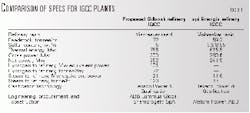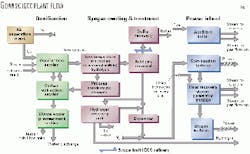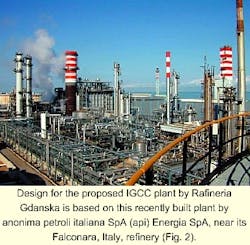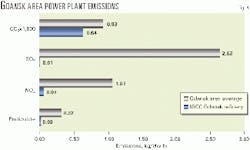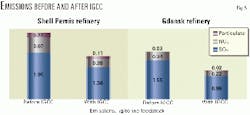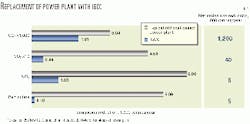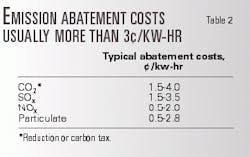The introduction of a new integrated gasification combined-cycle (IGCC) project in any modern refinery can offer significant environmental benefits.
It can reduce CO2 emissions by 40% and SOx, NOx, CO, and particulate emissions by 80%. These reductions will allow refineries to meet new and more stringent emission standards.
IGCC is a clean and efficient process to upgrade refinery bottoms to produce electricity.
Particularly, this article quantifies the benefits of installing a proposed IGCC project at the Rafineria Gdanska SA refinery in Gdansk, Poland. At the regional or national level, a CO2 emission reduction of between 1.2 and 1.6 million tonnes/year (tpy) would allow Poland to meet 5-6% of its CO2-abatement target under the Kyoto Protocol with this single project.
Withdrawal of 800,000 tpy of heavy sulfur fuel oil from the market will remove 50,000 tpy of SOx from the regional emissions. This is equivalent to about 5% of the national yearly SOx emissions.
An economic analysis indicates that the emissions reduction via IGCC is a significantly more cost-effective abatement approach than the application of alternative "end of pipe" abatement technologies such as CO2 sequestration, DeSOx, or DeNOx. The valorization of this environmental benefit results in a significantly lower net power-production price via an IGCC project.
Several publications have documented the benefits of IGCC and its gradual technology improvements during recent years.1-3 More recently, ABB's and Texaco's joint cost-reduction program has significantly reduced the total IGCC capital cost.4
Consequently, today in certain markets IGCC can produce power at purely commercial tariffs.
Gdansk IGCC project
Two forces are driving the proposed IGCC project at Rafineria Gdanska SA:
- The need to reduce refinery emissions to meet new environmental regulations, which will become effective in 2005, as in most European Union countries.5 6
- The desire to produce higher value-added products in place of heavy sulfur fuel oil, which is facing worldwide shrinking demand.
Several participants are developing the proposed IGCC project:
- Rafineria Gdanska SA, Gdansk, Poland (initiator of the project).
- Zespót Elektrocieptowni Wybrzeze Spótka Akcyjna SA, Gdansk, Poland.
- Hamburgische Electricitäts-werke Power Ventures GmbH, Germany.
- Texaco Power & Gasification Inc., White Plains, NY.
- Snamprogetti SpA, Milan, Italy.
- ABB Lummus Global GmbH, Weisbaden, Germany.
The proposed project will be divided into two related parts: refinery expansion and IGCC.
The proposed refinery expansion consists of revamping several existing units and expanding crude oil distillation capacity up to 6 million tpy. New units include a vacuum unit and a visbreaking unit to produce lighter distillates.
The Gdansk IGCC plant will gasify the visbreaker tar from the expanded refinery. The design feedstock is based on Ural crude. To maximize flexibility, however, the gasifiers will be able to process many other feedstocks, including tars produced from other crudes, and other types of heavy gas oils and refinery resids.
Table 1 shows the main specifications related to the proposed Gdansk refinery IGCC complex. Fig. 1 shows a block diagram of the IGCC plant with the individual units.
To save time and costs, the new plant will be designed analogously to the anonima petroli italiana SpA (api) Energia IGCC plant, recently built and now being commissioned by ABB and Alstom Power next to the api Falconara refinery in Italy.
Design of the new IGCC plant will be the same size but with the addition of recent improvements in cost reduction and technology.
For example, the proposed plant at the Gdansk refinery will produce more power using the same gas turbine. This achievement was possible with the reconfiguration of the combined-cycle power plant design, and this will contribute to lowering the unit production costs.
At the same time, the new plant will also produce 72 tonne/day of hydrogen for supply to the adjacent refinery.
Fig. 2 shows api Energia's IGCC plant. Table 1 compares the basic plant characteristics of the api Energia IGCC complex, currently in the last stages of commissioning, with the proposed refinery.
The emission predictions shown in this article are based on proprietary calculations and on preliminary test data from that plant.
Refinery emissions benefits
At present, Poland is restructuring its environmental practices and legislation to meet emission limits similar to those set by the European Union. Fig. 3 shows the new standards, as they relate to the Gdansk refinery.
Fig. 3 also shows the emissions expected after the introduction of the new IGCC project. The proposed IGCC plant will have a drastic improvement on the emissions, helping the refinery easily to comply with the new standards.
Another way to note this improvement is to compare, as shown in Fig. 4, the average emissions in the Gdansk area per Mw-hr of power-producing capacity7 to the projected emissions from the new IGCC complex.
Although each actual IGCC and refinery upgrading project has different specific details, because several units are typically reconfigured or revamped at the same time with the introduction of a new IGCC, the degree of improvement predicted for the Gdansk refinery is similar to the one measured for the Shell Pernis refinery near Rotterdam (Fig. 5).
Shell's Rotterdam refinery, one of the largest in the world, underwent an extensive upgrading program during 1993 to 1997 that included a new hydrocracker, several waste treating units, and an IGCC plant producing 285 tonne/day of hydrogen for the refinery and 110 Mw of electricity for the refinery and Dutch grid.
As a more complex refinery with a larger number of conversion units and associated heaters, the total emissions per unit of throughput at Pernis are naturally higher than those at Gdansk.
Regional impact
In addition to reducing local refinery emissions, Western Poland and the greater Baltic Sea region will benefit from the following two environmental improvements:
- Production of electric power in an environmentally cleaner way, reducing the power imports from older and more polluting facilities, typically based on coal, which could be shut down.
- Production halt of 800,000 tpy of heavy sulfur fuel oil for export.
On the production of power in a cleaner way, the net new production of 252 Mw can allow, for example, the shutdown of an old coal-based power plant producing 330 Mw net (to account for transportation losses) at a hypothetical location 500 km from the IGCC source.
It is assumed that this typical coal-based power plant is more than 30 years old and that it does not yet have modern abatement technologies.
As a matter of fact, Poland plans to shut down a sizable percentage of its old coal-based power plants, which will shortly reach the end of their useful lives.
Fig. 6 shows the significant reduction in CO2, SOx, NOx, and particulate emissions if the electricity produced from such an old coal-based power plant is replaced with an IGCC fueled with refinery residues.
From a technical viewpoint, the reduction in CO2 formation is a result of the much higher efficiencies of power production in an IGCC (typically 41%) with respect to an old power plant (typically 32%), as shown in Fig. 7.8
A further improvement in efficiency to 49%,9 using the most modern gas turbines, will have a further major impact on the CO2 emission reduction.
To put the CO2 savings in perspective, the projected CO2 reduction of between 1.2 and 1.6 million tpy, depending on the selected gas turbine, is equivalent to 5-6% of the Polish national commitment to reduce greenhouse gases under the Kyoto protocol.10
The SOx reduction is a consequence of the application of sulfur-removal technologies in the IGCC process. Indeed, elemental sulfur is a saleable by-product from IGCC.
The simultaneous application of low-NOx burners in the gas turbine and of the selective catalytic reduction (SCR) technology downstream contribute to the significant NOx reduction.
The application of modern gas turbine technology in combination with clean synthesis gas (syngas) as turbine fuel are the main causes for the huge reduction in particulate emissions, resulting in an almost negligible amount of particulate formation.
An alternative view on the environmental benefits of IGCC is the withdrawal of 800,000 tpy of heavy sulfur fuel oil from the bunker-fuel market. This will lead to a reduction of about 50,000 tpy of SOx emissions, equivalent to a reduction of 5% of the national annual SOx emissions. This reduction measured on a regional level overshadows the parallel reduction of SOx locally at the refinery, which was 1,000 tpy.
As a general conclusion, although an IGCC introduction will greatly assist a refinery to meet new and more-stringent environmental standards, even bigger environmental benefits will be observed by the wider community, such as an entire region or a nation.
Emission-reduction costs
Emission-abatement processes for existing power plants are typically passive investments. While the investment requires additional capital, it is not accompanied by an increase in production of power or other saleable commodities.
Table 2 shows typical investment and operating costs of several abatement technologies associated with various technologies.11-16
In retrofit of existing coal-based power plants, the simultaneous abatement of CO2, SOx, NOx, and particulate through a variety of available technologies will typically increase the power-production cost by more than 3
The same conclusion can be reached through the carbon tax costs, also a direct result of greenhouse-gas reduction programs. The carbon tax is applied in certain countries, and proposals for its extension are under study in several environments. A typical carbon tax of $50/tonne CO2 emitted17 will by itself result in the avoidance cost of 3¢/kw-hr.
The introduction of a new IGCC is by far a more economical way of satisfying new environmental standards than the retrofitting of an old coal-based power plant with similar capacity.
In the latter case, a passive investment is required, which would add at least 3¢/kw-hr to the total power manufacturing cost. An IGCC, on the other hand, produces power at unsubsidized power manufacturing costs ranging between 3¢ and 6¢/kw-hr, depending on plant size, location, feedstock price, and financing conditions, which makes this solution economically attractive in many world-wide locations.
Therefore, if even a small fraction of the passive cost incurred in retrofitted plants is applied to a new, more environmentally friendly IGCC project, the IGCC can become a far more attractive solution.
Acknowledgments
The authors thank several associates for their contributions to this article: Bernard Tripod , Karl Reyser, and Stanislaw Bulaj of Alstom Power; Michael Kowalik of HEW; Dale Simbeck of SFA Pacific; Juergen Karg of Siemens Power Generation; Marco De Palma of Snamprogetti SpA; Luke O'Keefe of Texaco Power and Gasification; P.J. Kooi of ABB Lummus Global.
References
- White, David, IGCC-commercial breakthrough of a clean generation technology, Modern Power Systems, April 1998.
- White, David, The role of CCGT's, Modern Power Systems, September 1998.
- White, David, IGCC: poised for growth?, Modern Power Systems, December 1998.
- Brkic, D., Cooperberg, DC, Wong, B., and Thone, P.W., Recent Cost Reductions Increase IGCC Competitiveness, Power Gen '99, Singapore; Gasification Technologies Conference, San Francisco, October 1999.
- Directive 98/70/ec of the European parliament and of the council of 13 October 1998 relating to the quality of petrol and diesel fuels and amending council directive 93/12/eec, www.europa.org.
- Rafineria Gdanska SA, proprietary information.
- Agencja Rynku Energij SA, Fuels consumption and emission of pollutants by public power plants, 2000.
- Karg, Juergen, Specific CO2 emission from different power plants as a function of net stations efficiency, Siemens KWU.
- Falsetti, J. and De Puy, R.A., From Coal or Oil to 550 MWe via 9H IGCC, Gasification 4 The Future, 2000.
- United Nations, Framework Convention on Climate Change, www.unece.org, Kyoto Protocol Document FCC/CP/1997/7 article 25, 1998.
- Environmental Catalyst Consultants Inc., Advances in Selective Catalytic Reduction for NOx Control, 1989.
- InfoMil, fact sheets, www.infomil.nl/lucht, 2000.
- Ministry VROM, Dutch Notes on BAT for Mineral Oil Refineries, www.infomil.nl/lucht/techniek, 1999.
- Texaco Power and Gasification, proprietary information.
- Simbeck, Dale R., Update of new power plant CO2 control options analysis, www.SFAPacific.com, 2000.
- ABB Power Generation Ltd., proprietary information.
- Haugland, Torland, A Comparison of Carbon Taxes in Selected OECD Countries, 1993.
The authors
Alexander A.A. Cabooter is a process engineer supporting the strategic business development efforts within ABB Lummus Global. He has held several positions in the process department group of ABB Lummus Global since 1995. Cabooter holds a degree in chemical engineering from the Haagse Hogeschool of The Hague.
Daslav Brkic is vice-president of strategic business development with ABB Lummus Global. In this position, he is responsible, among others, for the management of the ABB IGCC marketing effort. Previously, he has worked for ABB Soimi, Italy, as director of marketing and business development and with UOP in a number of marketing and management assignments in the US and UK. Brkic holds a PhD in chemical engineering from the Technical University of Milan, Italy, and Erlangen-Nuremberg, Germany.
Daniel C. Cooperberg is director of refinery planning and gasification technology development in the Lummus Technology Div. Among others, he is responsible for the technical leadership of the ABB Lummus Global IGCC program. In the last 20 years he has held several managerial roles in the fields of IGCC, syngas, and gasification processing. Cooperberg holds an MSChE degree from New York University.
Karol Sep is project development manager within Rafineria Gdanska and is responsible, among others, for the development strategy of the Gdansk refinery. He has been active in the oil sector in Poland and abroad for 30 years, holding several managerial roles. Sep holds an MSChE degree from Institut de Petrol si Gase, Bucharest, Romania.

